Research and Resiliency in Acadia
Protecting Acadia in a Rapidly Changing Environment
August 1st, 2023
Protecting Acadia in a Rapidly Changing Environment
August 1st, 2023
BY SHANNON BRYAN
Acadia’s forests, lakes, and coasts are being altered through land use, pollution, over-tourism, invasive species, and climate change. These changes are likely to continue and accelerate. Through its Wild Acadia initiative, Friends of Acadia has partnered with the park and Schoodic Institute to help park ecosystems be resilient to the changes. For nearly a decade, thoughtful science, forward-thinking management, organizational collaboration, and strategic investments at Cadillac Mountain, Great Meadow Wetland, and Bass Harbor Marsh have positioned Acadia National Park as a leader in climate-smart restoration. Now, the park and its partners are scaling up for even greater impact.
You can learn a lot from a plot.
Like how summit vegetation will naturally propagate in degraded areas – if you provide the soil and an effective way to keep it there. Or how planting native shrubs might provide just enough competition to keep invasive seedlings at bay.
Scientists in Acadia National Park have gleaned a good deal from study plots over the last several years.
On the summit of Cadillac Mountain, where decades of wandering foot traffic and the changing climate have diminished the vegetation, researchers experimented with soil blends and seedlings, testing which methods were the most effective. Now those learnings are being extended to Sargent and Penobscot Mountains.
Closer to sea level, dedicated efforts to suppress invasive plants in Great Meadow and Bass Harbor Marsh are being amplified, too. Study plots implemented this spring at ecologically diverse locations are being monitored to see how well native shrubs inhibit the resurgence of invasive plants like glossy buckthorn.
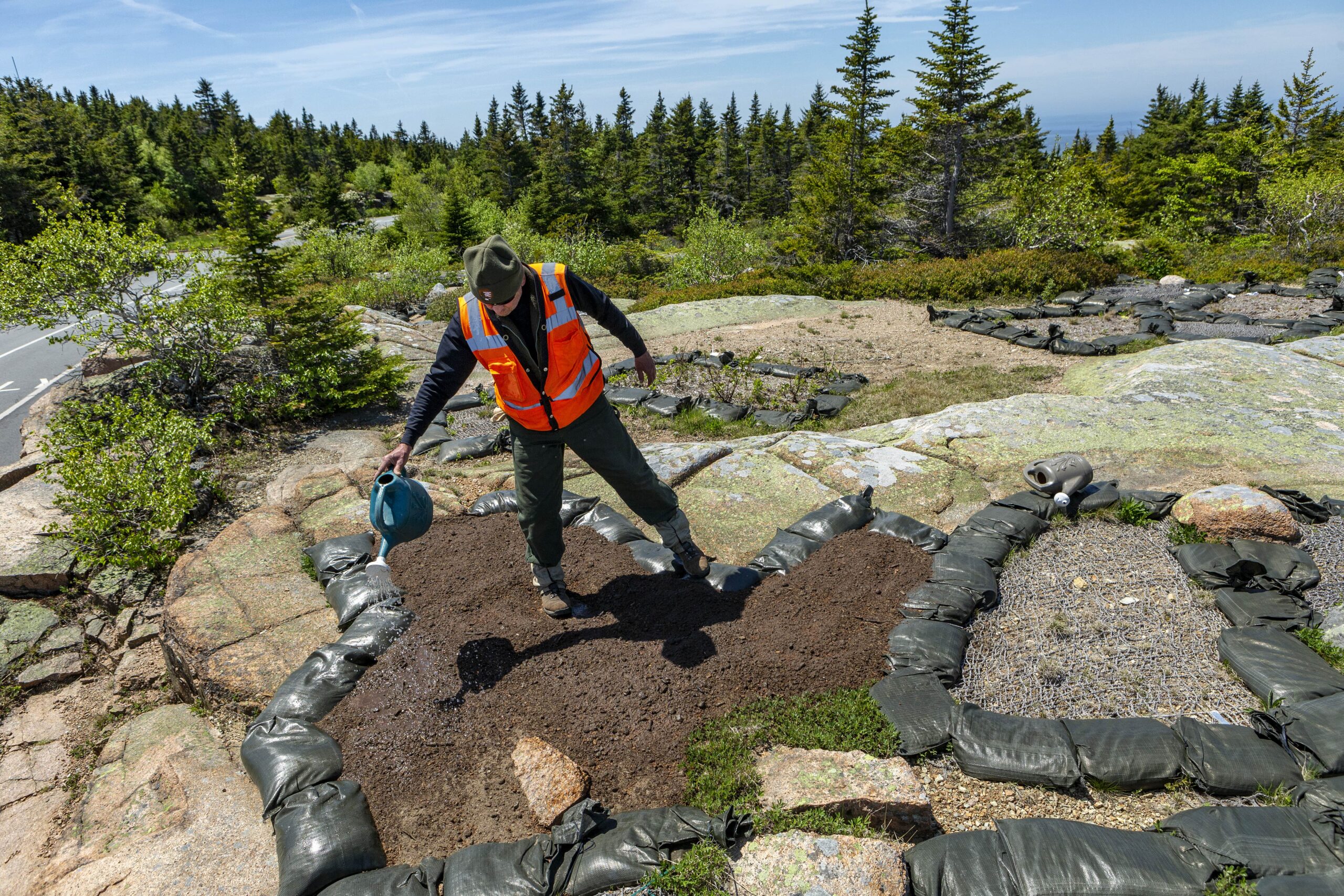
Jim Burka, Acadia National Park biological science technician, waters sterilized soil recently added to areas that will be revegetated near the summit of Cadillac Mountain. (Photo by Ashley L. Conti)
The current expansion of work is a testament to ongoing collaborative science and partnership between Acadia National Park, Schoodic Institute, and Friends of Acadia over the last decade. “For those first several years, we were doing a lot of pilots, a lot of learning on a small scale,” said Dr. Abe MillerRushing, science coordinator at Acadia National Park. “What’s exciting about now is we’re taking all that learning and we’re scaling it up.”
That initial work by Acadia and its partners enabled the park to take advantage of federal funding opportunities. Acadia has received $900,000 through the Bipartisan Infrastructure Law for projects at Great Meadow and Bass Harbor Marsh, with another $250,000 expected.
“It’s the kind of funding that really only comes along once or twice in a generation for resource management in the federal government,” said Miller Rushing.
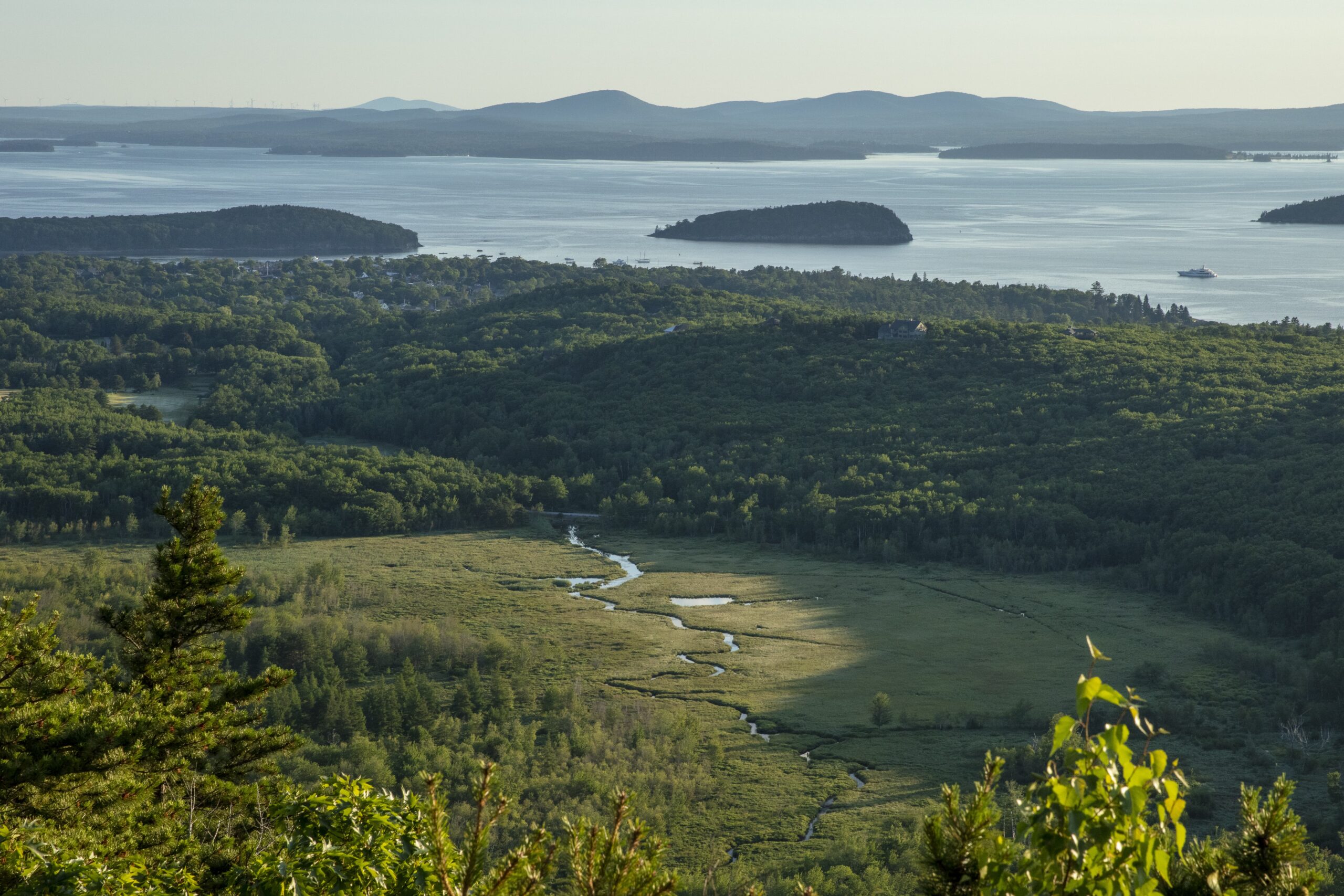
ACADIA NATIONAL PARK, MAINE – JULY 9 2022 — Great Meadow is warmed by early morning sunlight with Bar Harbor in the background as seen from Schiff Path on Saturday, July 9, 2022. (Photo by Avery Howe/Friends of Acadia)
That early work has also positioned Acadia as a leader in climate-smart restoration.
“The park service has tended to manage things to keep things the way they were in the past,” said Miller-Rushing. Now the approach is more deliberate, and it takes inevitable future change into consideration.
The new framework is officially known as Resist-Accept-Direct (RAD). It asks resource managers to consider differing options: Where do we want to hold the line and resist and try to prevent changes from happening? Where do we want to accept those changes? And where do we need to push things in a new direction?
There’s solid scientific basis for this climate-smart approach, and other parks around the country – and the globe – are taking note.
Acadia is sharing insights with other parks in the northeast and beyond. A team from Parks Victoria in Australia came to Acadia in June to learn about the work happening here. This summer, Dr. Chris Nadeau, climate change adaptation scientist at Schoodic Institute, is organizing a symposium at the Ecological Society of America meeting in Portland, OR, and Miller-Rushing is traveling to the biennial International Congress for Conservation Biology in Rwanda, all to share the lessons they are learning on the summits and in the wetlands of Acadia.
It’s work worth celebrating, but researchers recognize that it’s still early in a process that will be decades long.
“With climate change, we don’t know. It’s hard to predict which things are going to work and which aren’t,” said Miller-Rushing. “We’re trying to be as proactive as we can and to set ourselves up to learn as we go, knowing that conditions will be changing, and we’ll get surprised along the way.”
The low-lying, berry-producing shrubs, wildflowers, and lichens on Acadia’s summits are accustomed to harsh weather. But even hardy subalpine vegetation has its limits.
In addition to a changing climate, the trampling of vegetation by increasing numbers of visitors further challenges those summit ecosystems.
Simply roping off those areas – an effort tested for decades – did little to help vegetation rebound. The plants didn’t return because the seeds found no soil to grow in.
“When the vegetation died, soil washed or blew off the mountain,” said Dr. Chris Nadeau.
But collaborative on-summit research at Cadillac has led to a critical learning that’s now being expanded to the summits of Penobscot and Sargent Mountains. The key takeaway: If you provide the soil, the plants will come.

It’s a simple approach that enables nature to take its course – not to mention saving the cost and effort of not having to grow and transport seedlings or grown plants. But it’s not without complications.
“It’s the plants that really hold the soil on the mountain,” said Nadeau. “The soil needs the plants, and the plants need the soil.”
It’s a summit restoration rendition of the chicken and the egg: when soil is brought up to the summit, how do you keep it from eroding away again before seeds have a chance to take hold and grow?
And since neither Penobscot nor Sargent Mountains boast roads to their summits, as Cadillac does, what’s the best method to get and keep the soil up there?
The answer: Covering the plots with a coconut-fiber mesh helps keep the soil in place until vegetation can take root. The mesh additionally helps trap seeds and retain moisture, which is crucial in an environment that’s increasingly hot and dry.
The soil-and-mesh combination establishes a welcoming environment and allows nearby plants to naturally seed the plots-an approach decidedly easier and less expensive than growing, transporting, planting, and maintaining seedlings.
“If you plant shrubs where there was nothing, that kind of jumps nature’s natural process of succession,” said Nadeau. “What we found was that jumping the succession didn’t help.”
Instead, he said, they are setting the stage. “It’s passive restoration. The plants will be whatever naturally colonizes those areas.”
These learnings are now being implemented on Penobscot and Sargent Mountains, where 20 plots are being spread across both summits.
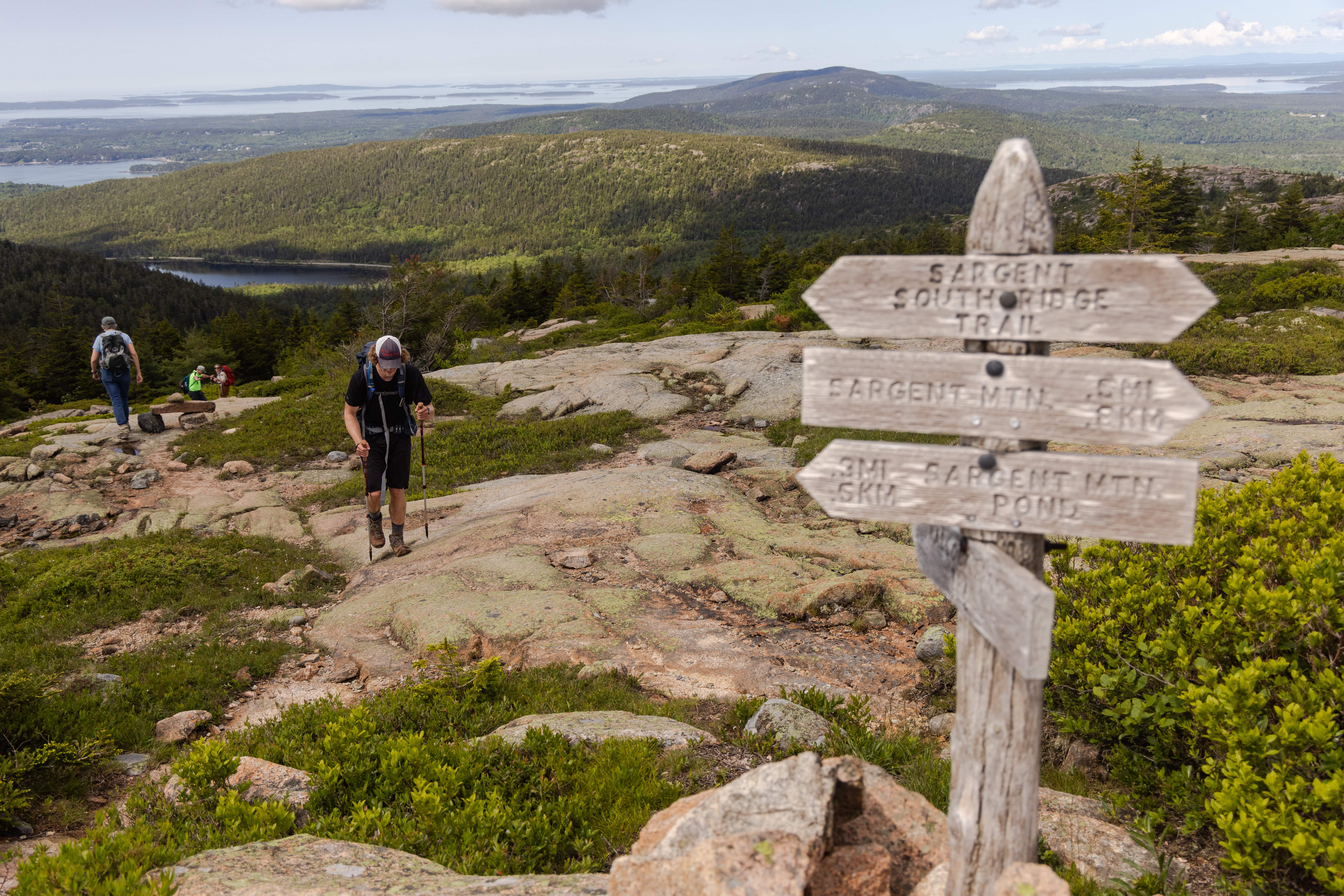
A volunteers hikes up Sargent Mountain with soil in his backpack during the Save our Summits event in June. (Photo by Sam Mallon/Friends of Acadia)
SOIL TO THE SUMMITS
A critical first step – getting soil up there – started this spring. It’s a human-powered effort with volunteers and staff carrying bags of soil to both summits.
June’s Save Our Summits event, a collaboration between Acadia National Park, Schoodic Institute, and Friends of Acadia, welcomed the public to participate. More events like that are in the works, both because many hands are needed to get an estimated 2,000 pounds of soil up two mountains, but also because communicating about these efforts is an important part of the work.
New methods are being tested on all three summits as well, like experimenting with mosses and lichens to see if they provide a nature-based solution to help hold in moisture during hot and dry spells.
To reduce soil erosion around the plots, they’ve switched to using biodegradable burlap bags instead of plastic sandbags. The burlap bags are filled with the same soil as the restoration plots, with seeds tucked in on top. “The bags naturally grow roots, and they biodegrade,” said Nadeau.
Experimentation is ongoing, and the process is a long one. “It takes decades,” said Jesse Wheeler, Acadia’s vegetation program manager and biologist. “That’s just the nature of growing on a windy, cold mountain summit. It’s just a hard place for a plant to live.”
But the park and its partners are dedicated to it.

Ethan Lewis, of Los Angeles, CA, who hiked with the Groundworks Bridgeport program, tosses a bag of soil into the pile atop Sargent Mountain during the Save our Summits hike. (Photo by Sam Mallon/Friends of Acadia)
“We’re aiming to prevent more loss. We can see the trajectory into the future with increased rainstorms and climate change,” said Wheeler. “So, let’s try to figure out what methods will work, what kinds of things we can do to hold the line for what’s there now, and hopefully improve and keep the habitat.”
At the base of Dorr Mountain, the 100-acre Great Meadow Wetland is part of a network of wetlands, streams, and ponds in the Cromwell Brook watershed. For most visitors who meander the lush paths or linger to bird watch, the ecosystem appears robust.
“To most of us, it looks pretty good,” said Jesse Wheeler, Acadia National Park vegetation program manager and biologist. “There are plants growing; there are beautiful sights to see.”
Understanding how the park’s ecosystems are changing requires a deeper look.

(Left to right) Jesse Wheeler, the vegetation program manger at Acadia National Park, Chanti Max, a plant technician with the Acadia National Park vegetation program though the ACE NPS Academy, and Taylor Palmer, a restoration technician with the Schoodic Institute, determine the boundaries of plots where fencing will go up to monitor the growth of glossy buckthorn. (Photo by Sam Mallon/Friends of Acadia)
Human modifications to the Great Meadow Wetland over the last hundred years have altered the flow of water and initiated a domino effect of changes. It’s a wetland that no longer functions like a wetland, which in turn allows invasive species to thrive.
Invasive plant suppression consumes a good deal of resources in most parks – Acadia included. But consistent funding from Friends of Acadia and other sources has allowed Wheeler’s team to manage more aggressively and stay relatively on top of the expeditious spread of invasives in areas like Great Meadow and Bass Harbor Marsh.
With the addition of federal funding from the Bipartisan Infrastructure Law, they’re now able to advance the work, taking an active restoration approach by experimenting with replanting natives where invasives have historically taken over.
This spring, Wheeler and Nadeau developed study plots to experiment with a diverse variety of native shrubs and grasses that can provide coverage and shading and give the invasive seedlings some competition. Glossy buckthorn happens to love sunny spots.
Plots are spread amongst wetter and drier areas, including an area close to the intersection of Jesup Path and Hemlock Road. Starting with shrubs helps managers get a slight jump on the effort, rather than waiting for seeds to take root and grow.
“We’ll still be here to manage invasive plants,” said Wheeler. “But this intervention should give our native plants a boost so that they are better positioned to keep glossy buckthorn or other invasive shrubs at bay with less help from us.”
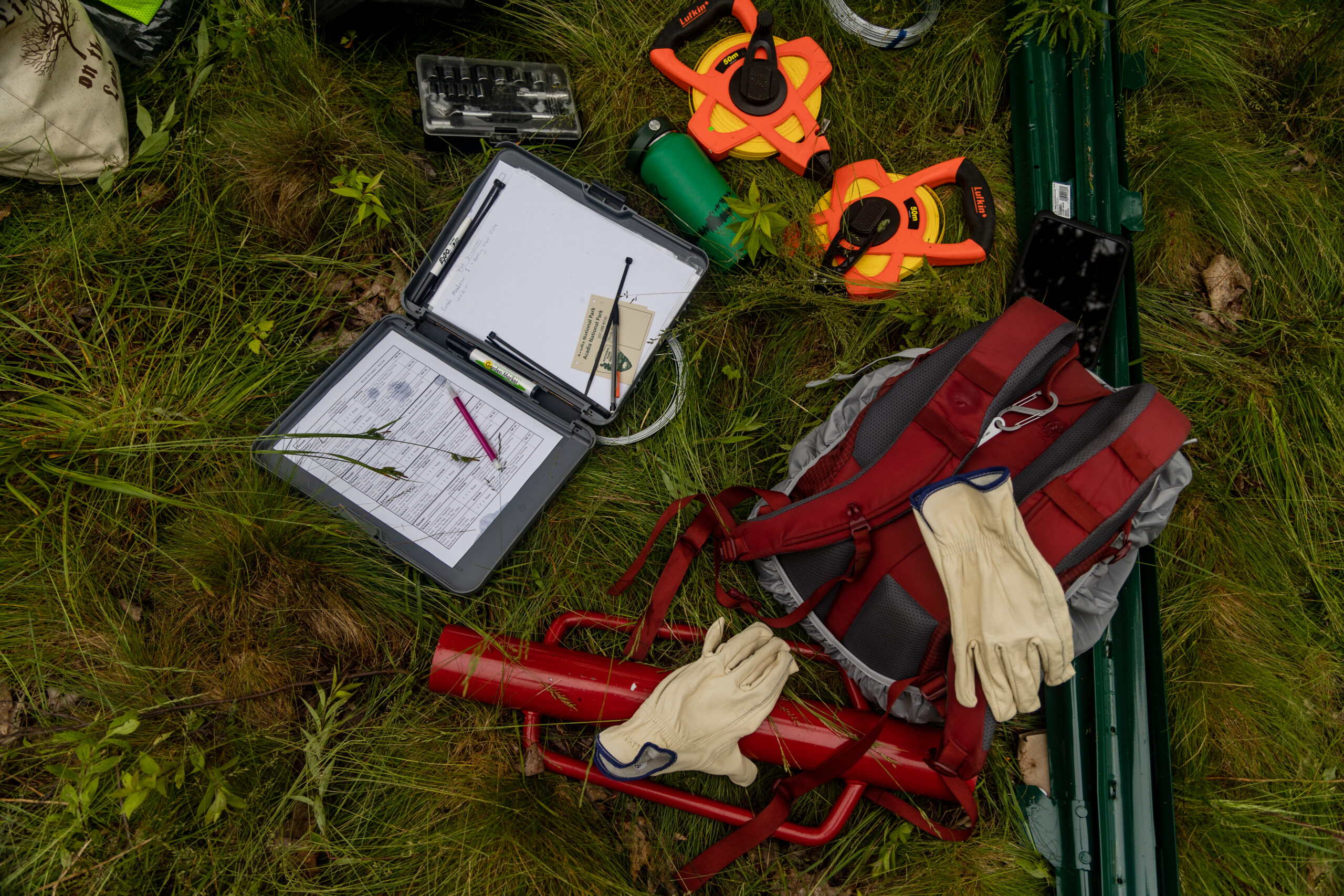
Materials from members of the Acadia National Park Vegetation Crew and the Schoodic Institute lay at their field site as they put fencing around a plot to monitor the growth of glossy buckthorn. The fencing is to ensure deer stay outside of the plot so plant growth and competition can be measured without deer eating the shrubs. (Photo by Sam Mallon/Friends of Acadia)
MORE STABLE HYDROLOGY FOR GREAT MEADOW
Rehabilitation in the wetlands also means creating a more stable hydrology and reducing other stressors. In recent years, water depth has fluctuated greatly from season to season, draining too quickly during dry periods and flooding during heavy rains. This January, following a heavy rainfall that fell on top of snow, flooding in Great Meadow was significant.
A big step toward reinstating a more natural water flow is taking place in 2024, when an undersized culvert is scheduled to be replaced with a larger one that’s better suited for the task.
“With a more stable hydrology in Great Meadow, we expect extreme floods like the one in January to become less frequent,” said Acadia’s Science Coordinator Dr. Abe Miller-Rushing. “We also expect native plants sensitive to disturbance to slowly move in, plants like those found in many of the park’s other healthier wetlands but currently missing from Great Meadow.”
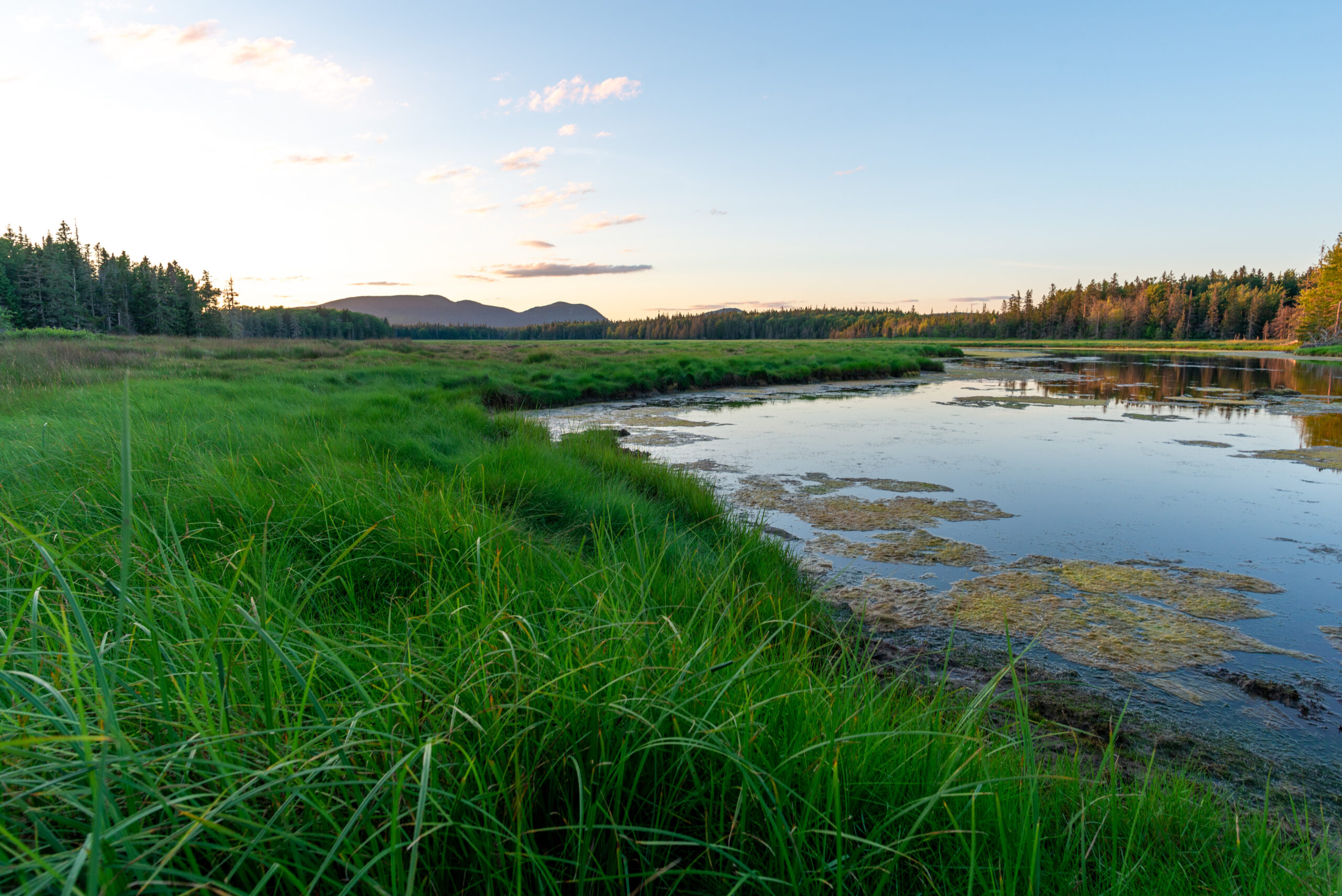
An evening at Bass Harbor Marsh in Acadia National Park. Photo Sam Mallon/FOA
ENGAGING AND EDUCATING PARK VISITORS
In the meantime, says Miller-Rushing, “We want the public to know that we’re shifting to managing change. That’s a big part of the story of Acadia right now. Acadia is changing and how we approach managing our natural and cultural resources is changing, too.”
The public can now see that shift with the plots on Acadia’s mountain summits, the Great Meadow Wetland, and Bass Harbor Marsh.
Newly placed informational tripods on top of Cadillac Mountain and at Great Meadow help tell the story of the work and its impact. The public can actively participate, as well, by helping to move soil or assisting with planting and monitoring.
“I think that’s really exciting,” said Miller-Rushing. “People are becoming more aware but are surprised at just how much it’s changed. I think that seeing and participating in the work can help bring that point home.
LEARN MORE
Learn more about the collaborative and climate-smart restoration work between Friends of Acadia, Schoodic Insitute, and Acadia National Park
Learn more about the Resist-Accept-Direct (RAD) Framework